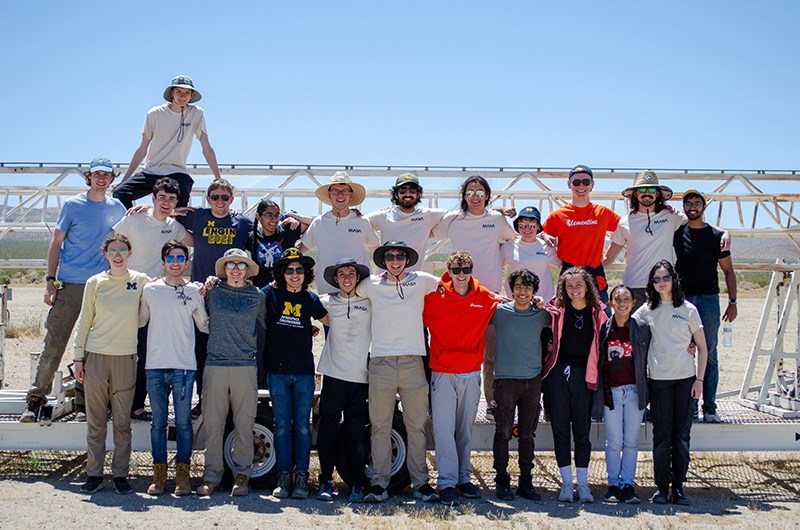
MASA Launches Clementine, the Largest Collegiate Liquid Rocket
After 2 years of work and over 100 team members contributing, MASA’s Clementine rocket is a success

After 2 years of work and over 100 team members contributing, MASA’s Clementine rocket is a success
After two years of building and testing, the Michigan Aeronautical Science Association (MASA) successfully launched the nation’s largest student-built liquid bipropellant rocket on May 14. Clementine, as they named their rocket, stood just over 20 feet tall and had a 10.75-inch diameter. It lifted off from the Friends of Amateur Rocketry (FAR) launch site in the Mojave Desert, California.
MASA is the student-run rocketry team at the University of Michigan that designs, builds, and launches liquid-fueled rockets. Clementine, MASA’s newest single-stage sounding rocket, was the team’s first to launch since 2018.

“Clementine was a huge success! Engineering is an iterative process, and it had been so long since the team had actually launched a rocket. We demonstrated many technologies the team has spent years designing and testing, but never in a fully integrated way. We are so excited to use what we have learned to keep making better rockets and engineers! Clementine is a huge step up in technical capabilities and demonstrates many things you need to start flying higher,” comments MASA team member Logan Harrold.
Their previous rockets used self-pressurizing nitrous oxide and ethanol for fuel instead of industry-standard cryogenic liquid oxygen and rocket-grade kerosene. They did not use a composite pressurant tank, and their engines were much more primitive, using simple showerhead injectors and ablative liners to stay cool.
However, this year’s record-setting rocket featured seam-welded propellant tanks, a regeneratively-cooled Kero lox engine, live in-flight telemetry, full-parachute recovery, and custom avionics PCBs — printed circuit boards that comprise an in-house flight computer, engine controller, and battery management board.
“We really stepped it up with Clementine,” Harrold said, “successfully using so many more technologies that are considered normal in the industry but have proven incredibly challenging for student teams.”
RP-D2, Clementine’s engine, is one of the most advanced engines in collegiate liquid rocketry, the team says. It is regeneratively cooled, meaning that it uses the flow of fuel through the engine to cool it down. It runs off RP-1 (rocket grade kerosene) and liquid oxygen, which are industry-standard propellants used on rockets such as the Saturn V and the SpaceX Falcon 9.
“It is one of the most powerful liquid engines to have been flown by a collegiate team, producing 1,500 lbs of thrust during takeoff,” said Kabir Bhatia, a member of the MASA team.

With all their success, the team still faced specific challenges with testing and the launch itself. The initial launch had to be pushed back one day due to high wind conditions and a last-minute technical issue.
“One of our pneumatic quick disconnects failed to actuate, so the rocket was tethered to the system, and we were unable to launch towards the end of Saturday. We resolved the issue and were confident Clementine would launch safely and successfully on Sunday,” MASA member Santhosh Sankar explains.
“Despite the team’s high hopes for a launch on our primary launch date, morale and confidence stayed high after determining we would need to move to our backup date. Our launch crew worked hard to ensure Clementine would successfully launch on our backup date,” Abbie Van Noord, MASA president, continues.
High winds continued on the day of the launch, causing problems with Clementine’s parachutes.
“Due to high wind, the rocket pitched over during flight. At its highest point, the rocket had more horizontal velocity than we accounted for. The airflow pushing the nose of the rocket, which contains the parachute, was higher than the system was designed to push against. The pneumatic system that separates the nose cone could not overcome this high airflow,” Kabir Bhatia states.
Clementine landed chaotically in the desert. The data analysis from the launch indicated a nominal 12-second burn and a stable flight lasting approximately 44 seconds.
Thankfully the team recovered the rocket and began the celebration of a successful launch!
Team members say they will take this as a learning opportunity leading into the hot fire of their next engine, the ME-5, and the launch of their next rocket, Limelight.
“We learned a lot about the importance of keeping things simple and reducing the number of failure points. This big mindset we are bringing into our next rocket is finding ways to reduce the number of components and complexity as we try to build something bigger, which has more thrust and flies higher than any other student team has ever flown,” said team member Logan Harrold.
This summer, the team is designing the propulsion components for its next rocket and beginning preliminary testing. They aim to have a fully assembled rocket engine ready for testing by the end of the fall semester, on schedule to launch in the Mojave Desert in the summer of 2025.